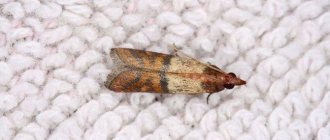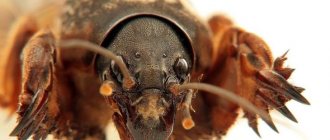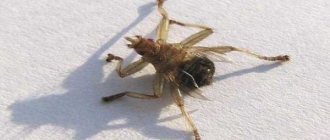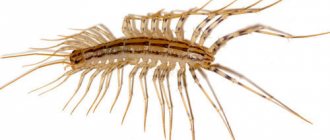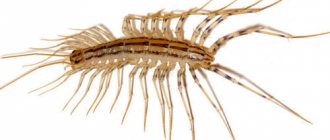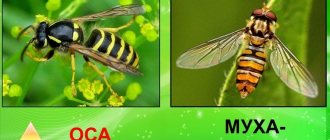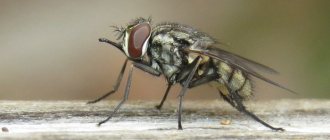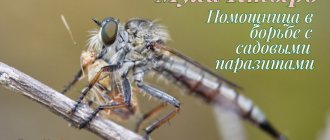The world of insects is very diverse and these small representatives of the fauna are not always harmless and safe. They can attack not only their immediate “masters,” but also humans. At the end of summer, especially in calm weather, there is a high probability of encountering a small blood-sucking parasite in the forest. This is an elk fly or a deer bloodsucker, an encounter with which does not bode well, because it can bite and be quite painful.
What does a deer bloodsucker (moose fly) look like?
Deer bloodsucker or moose fly, photo with wings
The size of the pest is 3-4 mm. It looks like a fly with a flattened body. It is due to its flattened shape that the parasite can withstand severe pressure from above. The covers are colored brown and have a glossy sheen. They are quite elastic and stretch significantly during feeding and during pregnancy. There are 3 legs extending from the chest on each side, there is a thickening on the hips, and claws are present. The wings are well developed, transparent, with a small number of veins, about 5.5-6 mm long.
The head of the moose fly is directed forward and flattened, like the body. The head of the bloodsucker is decorated with 2 eyes, located on the sides; they occupy a quarter of the entire head. The antennae are hidden in the frontal sockets, so they are almost invisible. The mouthparts are piercing-sucking type.
Ktyr
These flies, strictly speaking, have little interest in humans. Ktyri are active and aggressive hunters of insects. But, if touched or caught, they will definitely bite a person. The saliva of moths contains a strong poison, from which the insects caught by it die instantly, and a person develops painful swelling.
Eggs are laid on wood or grass, and the larvae feed on decaying organic debris.
How to identify a bird? They have large eyes and a slender, often elongated and usually short, densely pubescent, orange-yellow body. The sizes of the ktyres are very different, from 3 to 50 mm.
Reproduction of deer bloodsucker
Females produce several larvae during their lifetime. The deer bloodsucker has viviparity, i.e. she carries the egg to a pre-pupal state and only then gives birth to it. All the pupae need to do is harden and complete the pupal stage. At a time, the female lays only one prepupa, after which the next one begins to mature in the uterus.
The larvae mature in August-September. By mid-September, newborns are already growing wings. It is during this period that the greatest activity of deer bloodsuckers is observed. In general, in Russia, larvae hatch between August and October.
Green (carrion)
Despite its partiality to various kinds of carrion and sewage, this fly is a very beautiful insect with a glossy emerald body and translucent smoky wings with a faint openwork pattern. Its body length is about 8 mm. The fly's eyes are large, reddish, its abdomen is round, its cheeks are white. Green flies live mainly in dirty places : on decaying animal corpses, in manure, waste - but sometimes they can be
meet among flowering plants with a strong aroma. They feed on organic rotting matter, where they lay their eggs.
After mating, the female lays about 180 eggs. The egg has a grayish or light yellow tint. She tries to hide them as deep as possible in carrion, where they develop within 6–48 hours to the larval stage. The length of the larvae's body varies between 10–14 mm. After 3–9 days they leave their habitat and move to the soil to pupate. The pupal stage lasts from 10 to 17 days (depending on weather conditions), after which the insect emerges to the surface as an adult fly.
Lifestyle of the deer bloodsucker
Deer bloodsuckers attack exclusively during the day; at night they sleep. Individuals of both sexes feed on blood. Moose flies usually attack artiodactyl animals belonging to the cervid family (elk, deer, roe deer, deer) and cattle. Less commonly they feed on the blood of wild animals, for example, the blood of bears, wolverines, wild boars, badgers, and foxes. In addition, deer bloodsuckers can attack goats, sheep, dogs and even people. The pest sometimes parasitizes forest birds.
Although the moose fly can attack a person and feed on his blood, it cannot complete its reproductive cycle and produce offspring.
Interestingly, when it gets on the skin, the parasite sheds its wings, breaking them off at the base, and is held on to the victim with the help of its paws, which cling to the hair. For this reason, it can easily be confused with a tick.
Despite the fact that the parasite has wings, it flies very poorly. The deer bloodsucker prefers to wait for prey, sitting in the grass.
Usually the parasite is attached to its host and rarely spreads to other individuals. However, if a bird of prey kills its prey, the bloodsuckers on it move to a new host.
Deer bloodsucker, side view
Moose fly, appearance
Deer bloodsucker on hand
[edit] In addition
| ◄ ► |
NIN on topic And Petya Mamonov too The fly from “The Fly” looks at you like you’re food for larvae
- Mucha is the nickname of the St. Petersburg Academy of Arts and Industry named after. Stieglitz (former Mukhina Academy).
- The Fly is a hellish 80s film (with a terrible sequel) by David Croneberg. A remake of the 1958 film with Vincent Price, by the way.
- Mukha is the first magazine in Russia specializing in comics, originated in Ufa, published in 1991-93.
- Mucha is a famous Czech artist in Europe. However, in Europe he was called exclusively in the French manner, “Mushá”, in which pronunciation his name returned even to his native Czech Republic. The artist predictably did not object.
- Mukha is an RPG-18 anti-tank rocket-propelled grenade.
- Mukha is a Steyr Scout sniper rifle in counter mode.
- Jan Mucha is the goalkeeper of the Slovak national football team.
- Vitaly Petrovich Mukha - chief in the Novosibirsk region from 1991 to 1993 and again from 1995 to 1999.
- Renata Mukha is a children's poet.
- Fly on the Wall (Fly on the Wall) - the album of the most epic and award-winning group AC/DC, according to experts, is less successful. However, a series of music videos were released to coincide with the case, showing the songs being performed in a bar, using various special effects, including an animated subtitle.
- In Italian, “fly” will be mosca, and “Moscow”... the same Mosca, only with a capital letter.
How dangerous is the deer bloodsucker for humans and animals?
The pest prefers to feed on the blood of animals. It attacks people by chance when there are no deer, elk or wild animals nearby.
Deer bloodsucker attack on animals
The bloodsucker breeds on the body of large ungulates. The moose flies that parasitize the host are divided into pairs: the males are firmly attached to the females.
If a large population forms on the body of an animal, which continues to reproduce and regularly drinks blood, then the animal experiences serious discomfort, it stops eating and sleeping normally. Deer bloodsuckers feed 15-20 times a day, sucking 0.2-1.5 mg of blood at a time. As a result, some animals experience exhaustion, and young animals stop growing and developing. Regular blood loss in rare cases can lead to the death of the animal. Redness of the skin and papules appear at the sites of bites. The skin and fur of animals become heavily contaminated with parasite excrement.
The pest usually hides in the hair of ungulates on the neck and back, since these places have longer hair. Up to 1000 pests or even more can hide on one animal. The parasite feeds on the blood of the animal for 5-6 months.
Many types of bloodsuckers cause significant damage to animals. A pest that parasitizes sheep completely depletes the animal over several life cycles. As a result, the sheep develop skin inflammations and lose their wool.
Attack of a deer bloodsucker on a person
Deer bloodsucker (moose fly), appearance without wings
Although the moose fly will not specifically attack a person, it may well be a parasite on humans. Hunters are often attacked while cutting up their prey. In addition, a fly can attack a person in motion, because it reacts to movement and heat. Flies usually end up on people by mistake, so adults are more likely to be attacked than children.
The deer bloodsucker attacks unnoticed. Flying around a person, the parasite selects a landing site and then quickly sheds its wings. A person may think that he has brushed off an annoying fly, but after a few minutes the bloodsucker will dig into the skin. The bloodsucker rushes at people only in the absence of animals, simply confusing the victim. Pests often attack in a small flock.
Once on a person, the bloodsucker usually moves upward, trying to get into the hair or under clothing. A moose fly cannot be frightened by sudden movements, and it is not so easy to remove it. She doesn’t start biting immediately, but after about half an hour or an hour.
There is no identical reaction to a bloodsucker bite. Some people tolerate it easily, forgetting after a couple of days, while others suffer for several weeks. The consequences of a bite are also different and depend on individual sensitivity to the parasite’s saliva.
Human reaction to a moose fly bite:
- itching;
- red swelling at the bite sites;
- papules;
- increase in body temperature.
It happens that at first the bite of a deer bloodsucker is practically unnoticeable, but after a few days signs begin to appear: itching, papules, redness, etc. In some cases, a person may develop dermatitis and other skin diseases.
If a person is bitten by an elk fly several times in a row, the reaction to the parasite’s attack becomes stronger and the consequences are more severe.
Prevention
To protect yourself from deer fleas, you need to follow the following preventive measures:
- You should not visit the forest during the period when insects are active, which usually occurs at the end of summer and beginning of autumn.
- Choose suitable clothing. It should be as closed as possible and made of dense fabrics.
- Use repellent before going into the forest. Use them not only on skin, but also on clothes and accessories.
- It has been proven that deer fleas can attack humans only during daylight hours, since they are to a certain extent guided by vision when choosing a victim. Therefore, if you avoid walking in the forest during the day, you can protect yourself from parasites.
- Hunters are at particular risk. Cases of mass attacks on humans are often recorded during the cutting of artiodactyl animal carcasses, so it is advisable to be fully armed during such a procedure. To do this, put on a mosquito net, protective suit and gloves in advance.
Now if you encounter deer fleas, you will know how to get rid of them. But it’s better to worry about protection in advance and follow preventive measures.
What to do if you are bitten by a moose fly?
If there is a parasite on the body, then, of course, it must be removed. There are several methods you can use to remove moose flies from your body:
- using tweezers. To do this, you need to hold the insect with tweezers and carefully pull it out with twisting (counterclockwise) movements;
- using thread. Fold the thread into a loop, secure it to the insect and remove the bloodsucker using rocking movements;
- using rich cream or oil. You need to apply a thick layer of cream or oil to the affected area of the skin and wait. Due to the oil film, the moose fly will stop receiving oxygen and will detach from the body after about 15 minutes.
The parasite should be removed carefully, as otherwise there is a risk of incomplete removal of the parasite.
Afterwards, the bite site must be treated with an antiseptic: hydrogen peroxide, chlorhexidine, etc. To relieve itching and swelling, you can apply ice, treat the skin with aloe juice, calendula tincture, or a special ointment (“Rescuer”, “Ambulance”, “Zvezdochka” and etc.). If the symptoms after a bite are pronounced, it is recommended to take an antihistamine. If necessary, consult a doctor.
Fighting bloodsuckers
To protect yourself from a specific insect, you must adhere to basic preventive rules:
- Treat the area adjacent to the house with insecticidal preparations that are safe for people, indoor plants and pets. For this purpose, special devices are used that break down the poison into cold steam.
- If a flat fly is found in an apartment, you can get rid of it using repellents or professional control by spraying carbon dioxide, the liquid fraction of which has a temperature of -50°C.
- Regularly mow tall and dense thickets of grass.
- Spray lawns and trees with water with additives of crushed garlic and alcohol or decoctions of tansy and wormwood.
- Use strong repellents containing DET or perform water treatments with tar soap foam.
All this will become a reliable barrier for moose flies and protect people and animals from dangerous bites.
How to protect yourself from a moose fly attack?
When heading into the forest, you should cover all parts of your body as much as possible. It is recommended to wear overalls, pants and a jacket with long sleeves; you need to tuck your pants into your socks; the cuffs on the jacket should be tightened with an elastic band so that they fit snugly to your arms. It is also advisable to cover your head with a scarf or hat.
Repellents such as “Raptor”, “Komaroff”, “Argus”, etc. will also help to avoid insect attacks.
After each outdoor recreation, you should carefully inspect your clothing and body surfaces in order to quickly detect and remove the parasite.
[edit] Fly link
- Brutal abuse of flies.
- Why does a fly fly? Debriefing adapted for people suffering from PGM.
- The tsetse fly is plaguing Africa.
- Korney Chukovsky “The Fly Tsokotukha.”
- An interesting page with interesting facts from the life of flies. And another one.
- On the genealogy of Mukha-Tsokotukha - a study of the literary origins of K. Chukovsky’s work. Science, yup!
| [ + ] Fly - domestic animal harmful insect | |||||||||||||||||
| |||||||||||||||||
| [ + ] The fly has something to do with the fact that it flies. | |||||||||||||
| |||||||||||||
Incubation period
The incubation period is the time that elapses from the moment a person comes into contact with the pathogen until signs of infection appear. For the Delta strain, scientists reliably calculated the duration of the incubation period; it was 4.4 days. For the new strain, the exact duration of the incubation period is not yet known. The incubation period for omicron is expected to be 3-6 days, but it can vary significantly from country to country. The rapid increase in the number of infected people indicates a decrease in the duration of the incubation period.

